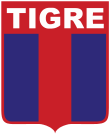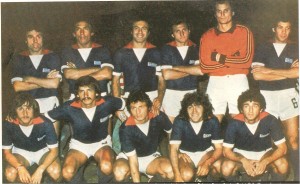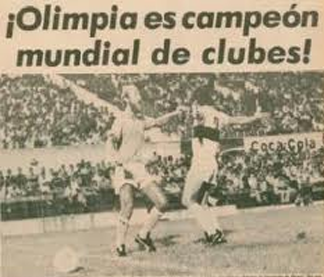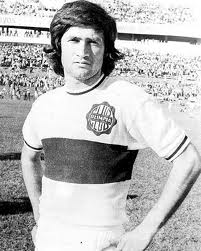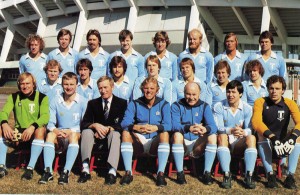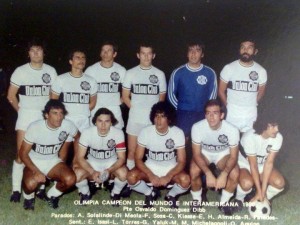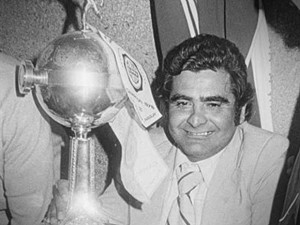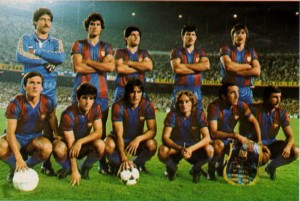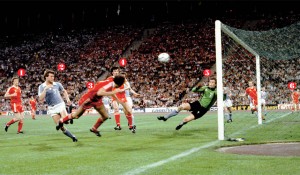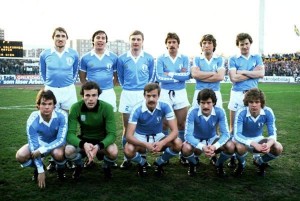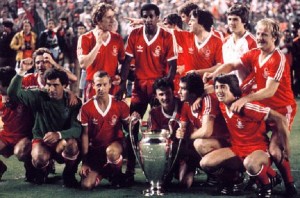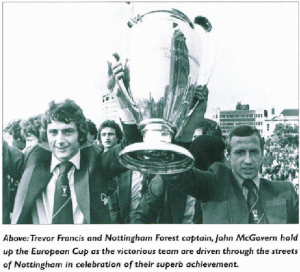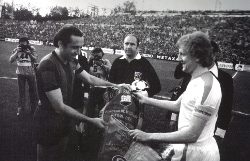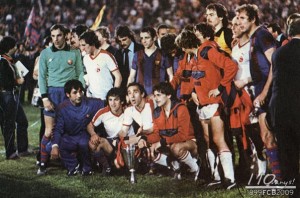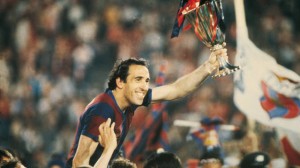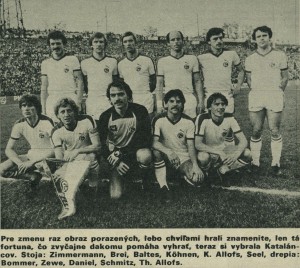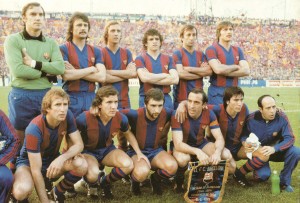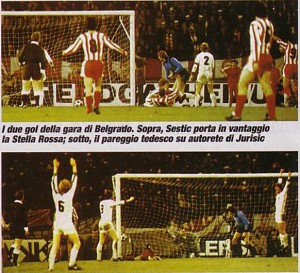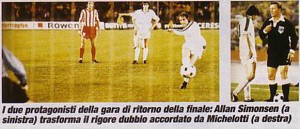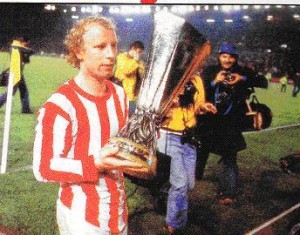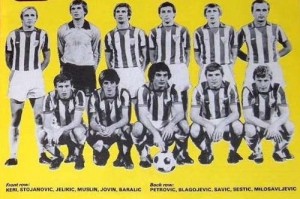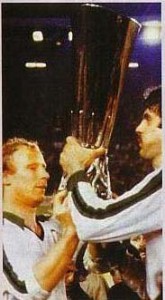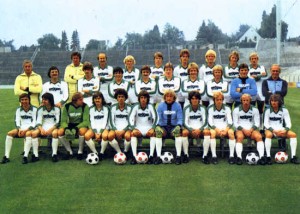Of course, Olimpia won Copa Libertadores before winning the Intercintinental Cup. The formula of Copa Libertadores was part of the problems of the Intercontinental Cup – the tournament kicked in March and ended in July. There was no other way, however, considering the South American championships. Boca Juniors – reigning holder of the Cup – got a bye and proceeded directly to the semi-final stage. All others played the preliminary groups – 5 of them, 4 teams of two countries in each. Some easier than others: Group 4 was perhaps the easiest, for there Venezuelan teams played against Chilean representatives. The toughest was Group 3, opposing Peruvian to Brazilian teams. Only the winners went to the semi-final stage. Independiente (Avellaneda) won Group 1. The other Argentine representative – Quilmes, also from Avellaneda, ended last. Something expected… Quilmes were just happy to play in the tournament, the Colombian teams – Deportivo Cali and Millonarios – were not at the general Argentine level. In Group 2 Paraguayan teams were favourites – Bolivia did not count much. But the difference was no all that big and a single point was the difference between losers and winners – Bolivar (La Paz) ended with great scoring record, but with 9 points. Olimpia (Asuncion) won 5 of their 6 matches and lost one – to this very Bolivar in La Paz. Yet, 10 points were better than 9 and Olimpia went ahead. Group 3 was the most interesting group and also most surprising: Brazilian teams were naturally favoured over the Peruvians, and Palmeiras was the big name here. Alianza (Lima) was the likelier stronger Peruvian club… historically. Alianza was unable to get even a point, losing all their games and scoring only 5 goals. Palmeiras finished 3rd… The battle was between Universitario (Lima) and Guarani (Campinas) – the Brazilian team prevailed. No contest in |Group 3 – the Venezuelan teams did not win a single match. It was Chilean battle of sorts – O’Higgins (Rancagua) was not really at the level of Palestino (Santiago), which won the group without losing a match and receiving only 2 goals in their net. In the Group 5, the Uruguayan teams were considered stronger and they were – the two Ecuadorian clubs achieved a combined record of 7 points: the same as Nacional (Montevideo). Which finished 2nd , 3 points behind their arch-rivals Penarol. Like Palestino, Penarol did not lose any match and received only 2 goals.
The winners of the five groups, plus Boca Juniors, went to the semi-finals – two round-robin groups of three teams each. Group 1 looked tougher – as far as names go. Boca Juniors, Independiente, Penarol… Uruguayan football was not great in the 1970s, so Penarol was out of the race. Since goal-difference did not count in South America, there was no group winner – the Argentine teams finished with 5 points each. A play-off was staged in Buenos Aires – regular time ended scoreless amd only in the extra time Boca won, thanks to their star Mastrangelo.
In the other semi-final group no such drama happened – Olimpia (Asuncion) was way above the rest. Guarani (Campinal) and Universitario (Lima) did not won a single match. In contrast, Olimpia did not lose any – they finished with 3 wins and 1 tie. Four points ahead of Guarani and the battle was actually finished before the last match between the two clubs in Campinas: by the time, Olimpia had 6 points and Guarani – 2. The last match did not matter at all – Guarani blew their chances four days earlier, when they were unable to beat Universitario at home.
Thus, Boca Juniors and Olimpia reached the final. It was seemingly easy to predict final: Boca Juniors won the last two Copa Libertadores tournaments, Argentina was the reigning football world champion, and since 1966 Argentine clubs did not win Copa Libertadores only twice – in 1971 and 1976. For Boca Juniors it was 4th consecutive final and it looked like they were building a dynasty, following in the steps of Independiente (Avellaneda). Olimpia was the underdog by far… once they played at the final, and lost it. It happened in ancient time… in the very first Copa Libertadores, in 1960. Paraguayan football did not make much news anyway, but although the newest football sensation was Paraguayan, he was not playing for Olimpia. Still, a final is a final… anything was possible, especially in South America. Olimpia hosted the first leg of the final and won 2-0 – both goals were scored early in the match.
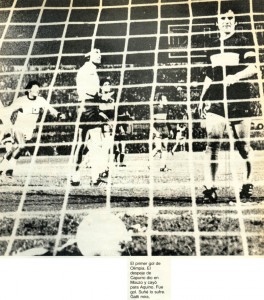
Aquino surprised Boca in the 2nd minute – 1-0.
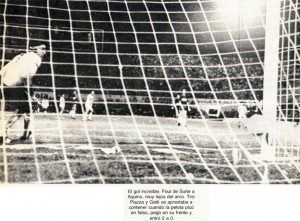
2-0 in the 27th minute – Piazza doubled the lead. Perhaps Boca did not take the opposition too seriously… but if that was the case, they paid dearly. Paraguayan players were never famous, but they were historically very tough. The result stayed unchanged.
1st leg. Defensores del Chaco, Asunción, 22- 7-1979
Olimpia – Boca Juniors 2-0
2′ Aquino 1-0
27′ Piazza 2-0
Olimpia: Almeida, Paredes, Jiménez, Solalinde, Kiese, Piazza, Isasi, L. Torres,
Villalba, Talavera, Aquino.
Boca Juniors: Gatti, Pernía, Capurro, Mouzo, Bordón, J.J. Benítez (Palacios),
Suñé, Salinas, Mastrángelo, Salguero, J.R. Rocha.
Referee: Castro (Chile)
Attendance: 50,000
Five days later Boca hosted the second leg. They tried to win, they failed…

 The match ended 0-0 and Olimpia triumphed at legendary La Bombonera.
The match ended 0-0 and Olimpia triumphed at legendary La Bombonera.
2nd leg. Estadio La Bombonera, Buenos Aires, 27- 7-1979
Boca Juniors – Olimpia 0-0
Boca Juniors: Gatti, Pernía, Sá, Capurro, Bordón, J.J. Benítez, Suñé,
Zanabria (Salguero), Mastrángelo, Salinas, J.R. Rocha (Palacios).
Olimpia: Almeida, Solalinde, Paredes, Jiménez, Piazza, L. Torres (Guasch), Kiese,
Talavera, Isasi, Villalba, Aquino (Delgado).
Referee: Cardellino (Uruguay)
Attendance: 65,000
 Fans rushed on the pitch to celebrate with their heroes – Piazza in the middle.
Fans rushed on the pitch to celebrate with their heroes – Piazza in the middle.
 Then the Cup was presented to the new winners.
Then the Cup was presented to the new winners.
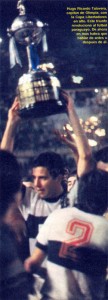 Hugo Talavera proudly shows it the crowd – it was great moment. Not only Olimpia won for the first time and on hostile stadium; not only they were the first Paraguayan winners – they were the first club outside the big trio of Argentina, Brazil, and Uruguay to win Libertadores Cup. It was the first international trophy for Paraguayan football since 1953. Fantastic moment.
Hugo Talavera proudly shows it the crowd – it was great moment. Not only Olimpia won for the first time and on hostile stadium; not only they were the first Paraguayan winners – they were the first club outside the big trio of Argentina, Brazil, and Uruguay to win Libertadores Cup. It was the first international trophy for Paraguayan football since 1953. Fantastic moment.
Boca Juniors played their third consecutive final and lost it.
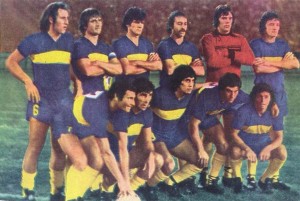 Standing from left: Mouzo, Sune, Zanabria, Pernia, Santos, Bordon.
Standing from left: Mouzo, Sune, Zanabria, Pernia, Santos, Bordon.
Crouching: Mastrangelo, Salguero, Benitez, Perotti, Suarez.
This is not the team which lost to Olimpia – it is rather an illustration of the small shortcomings of Boca. Strong team, to be sure, but hardly one to build a dynasty. Strong players, long squad – Gatti, Squeo, Sa, Capurro, Palacios, Salinas , Rocha, the list was long. Experienced stars, but.. hardly top rate. There was something missing – a bit more class, a bit more talent, a bit more will. Boca Juniors won twice, but failed at the third attempt. Yet, they stayed as leading Argentine team and one of the strongest in South America at the time. Only they were not extraordinary.
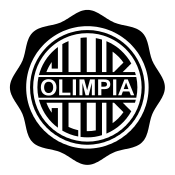
Fantastic year for Olimpia – their first, but not last international success. Starting as underdog,
the Paraguayans conquered Copa Libertadores in style: they lost only one match during the whole campaign: the away match against Bolivar (Bolivia) in the first round. It was small loss – 1-2. At the final Olimpia did not even allow Boca to score a goal, keeping a clean sheet. It was historic victory in every aspect, even the small one of using sponsor’s add on their shirts – they were first in that.
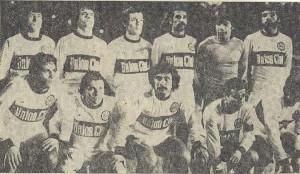 Crouching, from left: Isasi, L. Torres, Villalba, Talavera, Aquino.
Crouching, from left: Isasi, L. Torres, Villalba, Talavera, Aquino.
Standing: Solalinde, Paredes, Kiese, Gimenez, Almeyad, Piazza.
Anonymous team… no wonder nobody paid attention to them. But it was not a team of lucky nobodies – it was well made team, combining experience with young talent. Paraguayan players were never famous, but one has to keep in mind that most players of this team were members of the national team – and they were yet to add another victory this year. It was more than just promising bunch – some of this team would play and define the national team of Paraguay for years. Plenty of talent, which Luis Cubilla utilized in great way. Carlos Kiese (b. 1957), Osvaldo Aquino (b. 1952), Rogelio Delgado (b. 1959), Evaristo Isasi (b. 1955), Alicio Solalinde (b. 1952), Roberto Paredes, Luis Torres, Ruben ‘Toto’ Gimenez, and the missing on the photo Jorge Guasch (b. 1961) – young and bright, most of them already members of the national team, and they all played for it long. Hugo Talavera (b. 1949), the veteran, providing class and authority, also was a national team regular. One and a half foreigners completed the team with their solid experience: both were Uruguyan born. The defender Miguel Angel Piazza (b. 1952) was not famous, but was well respected player, who already had played for serious clubs (Penarol and the Argentine San Lorenzo and Newell’s Old Boys). The goalkeeper Ever Hugo Almeyda (b. 1948) was a different story – he started his career in Uruguay back in the 1960s, but joined Olimpia in 1973 and played for the club until 1991! In 1975 he took Paraguayan citizenship and was included in the national team – he played 22 games for Paraguay. Already old, experienced, solid keeper. And he was not the only player loyal to Olimpia – most of this team played long years for the club. They became instant legends and remained so for the club, but most of them had big role in Paraguayan football of the 1970s and 1980s too. A great team. And Cubilla – also remarkably loyal to Olimpia – saw their potential, trusted them, and shaped them into internationally successful squad. Young coach and young squad – what could be better: thanks to this year Olimpia joined the ranks of the best South American clubs – and stayed there.
 Taubate still won a trophy this year – champions not playing on national scale.
Taubate still won a trophy this year – champions not playing on national scale. Capivariano – curiously blond-looking team: standing from left: Wilson, Ze Guilherme, Sergio, Milo, Alemao, ?
Capivariano – curiously blond-looking team: standing from left: Wilson, Ze Guilherme, Sergio, Milo, Alemao, ?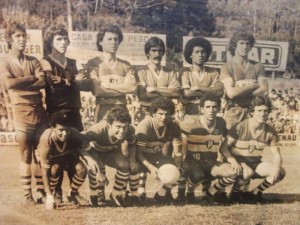 Palmeiras Blumenau, Amazonas state. Standing, from left: Valmir, Nilson, Pedrão, Dito-Cola, Saulo, Valmir.
Palmeiras Blumenau, Amazonas state. Standing, from left: Valmir, Nilson, Pedrão, Dito-Cola, Saulo, Valmir. America Sao Jose Rio Preto, Sao Paulo – note the fans on the stands. Quite many for unheard-of club.
America Sao Jose Rio Preto, Sao Paulo – note the fans on the stands. Quite many for unheard-of club. Two former Botafogo players here.
Two former Botafogo players here.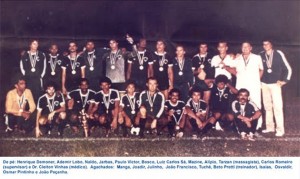 One more club not even known, yet with a trophy – international one this time: Vitoria won the 9th President Park Chung-Hee Cup in South Korea. Today the tournament is known as Korea Cup, Vitoria is still unknown.
One more club not even known, yet with a trophy – international one this time: Vitoria won the 9th President Park Chung-Hee Cup in South Korea. Today the tournament is known as Korea Cup, Vitoria is still unknown.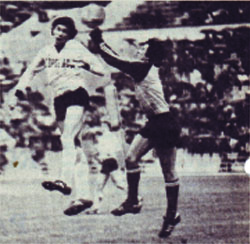
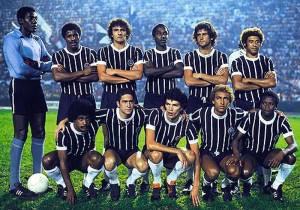
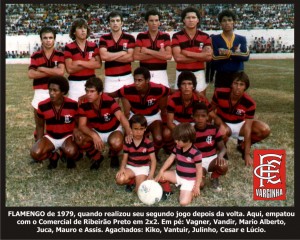
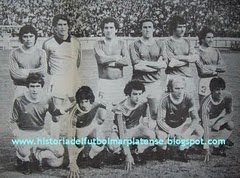


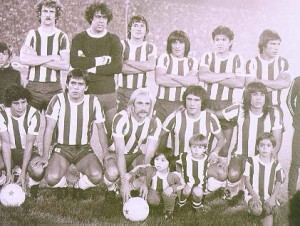


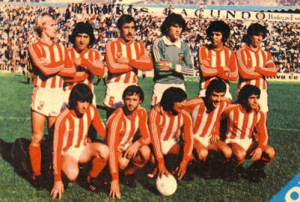
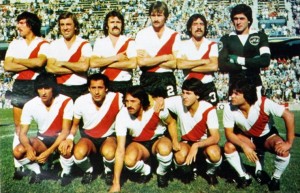

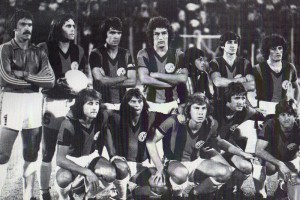
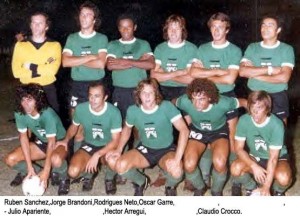
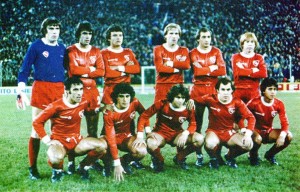
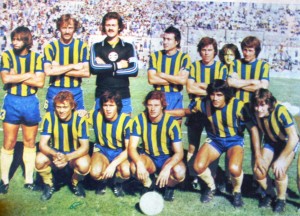

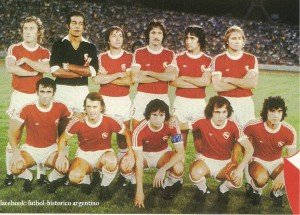


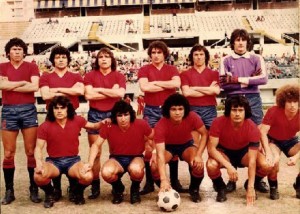
![Temperlay1979[1]](/wp-content/uploads/2015/01/Temperlay19791-300x236.jpg)
